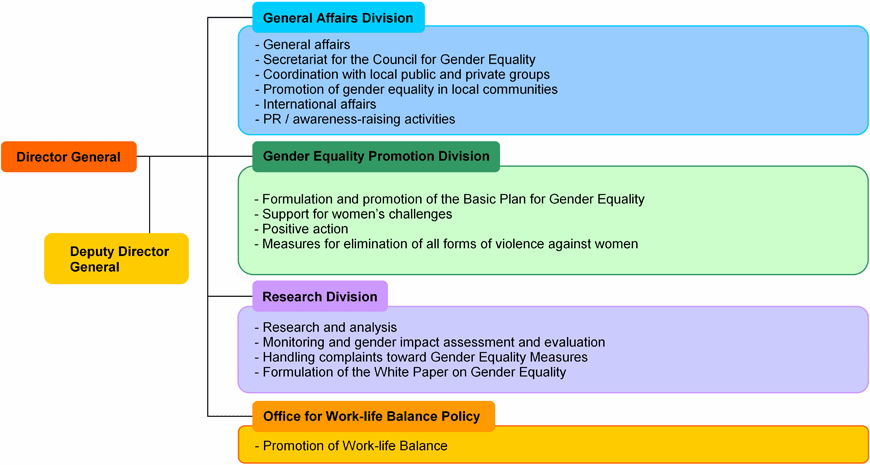
Headquarters for the Promotion of Gender Equality
The Headquarter for the Promotion of Gender Equality (hereinafter referred to as "Headquarter") was established as the body to facilitate smooth and effective promotion of measures regarding the formation of a gender-equal society. The prime minister chairs the proceedings of the Headquarter, and the chief cabinet secretary and the minister of state responsible for gender equality serve as deputies for the prime minister. The Headquarter comprises all Cabinet ministers, and high level government officials such as director-generals from the ministries and agencies concerned are appointed by the prime minister to act as coordinators for gender equality. The coordinators for gender equality from each ministry or agency hold regular meetings as a means of enhancing inter-ministerial cooperation.
Council for Gender Equality
The Council for Gender Equality serves three major purposes. Firstly, it is required to submit its opinions with regard to the Basic Plan for Gender Equality to the prime minister.
Secondly, the Council is required to study and deliberate upon basic policies and measures and important matters with regard to promotion of the formation of a gender-equal society in response to consultations with the prime minister or other Cabinet ministers.
The results of study and deliberation are then submitted to the prime minister or the Cabinet ministers for their consideration.
The third purpose of the Council is to monitor the implementation status of government measures for a gender-equal society and study the impact of government measures on the formation of a gender-equal society. Results and opinions are submitted to the prime minister and other Cabinet ministers.
Liaison Conference for the Promotion of Gender Equality
The Liaison Conference for the Promotion of Gender Equality was inaugurated in 1996 with a view to promoting the exchange of information and ideas as well as to facilitating necessary coordination among all sectors and levels of society, in order to promote national activities to create a gender-equal society.
This conference holds plenary meetings twice a year, in addition to which hearing sessions are held on a flexible basis in order to promote information and exchange opinions with the general public from all levels and sectors of society, thereby actively pursuing initiatives for the creation of a gender-equal society.
In order to step up its developmental activities throughout Japan to accelerate progress towards the achievement of gender equality, the Liaison Conference makes use of its nationwide network. Also, in cooperation with the Regional Liaison Conferences for the Promotion of Gender Equality, which have set up a "national-regional network for gender equality", the Liaison Conference is actively implementing a wider variety of more effective initiatives.
Gender Equality Bureau
The Gender Equality Bureau of the Cabinet Office serves as the secretariat for the Headquarters, the Council for Gender Equality and the Liaison Conference for the Promotion of Gender Equality. It is responsible for overall planning and coordination of various matters related to the promotion of the formation of a gender-equal society.
Moreover, the Bureau compiles the government white paper entitled Annual Report on the State of Formation of a Gender-equal Society. The planning and implementation of study and research are also the responsibility of the Bureau, as are publicity activities and awareness raising efforts among the public. In publicity and awareness-raising efforts the Bureau cooperates with local governments, non-governmental organizations (NGOs), and international organizations.
Local Government
Sections in the local governments (47 prefectural governments and approximately 1,800 municipalities) in overall charge of administration and liaison conferences to promote the formation of a gender-equal society are placed in departments with various names. 47 prefectural governments and 896 municipalities have established consultative panels and councils to consider important issues related to gender equality, and 47 prefectural governments and 852 municipalities have liaison conferences to coordinate relevant departments within their offices. 47 prefectural governments and 1,141 municipalities have adopted a basic plan for gender equality, and 46 prefectural governments and 496 municipalities have enacted the ordinance for the promotion of gender equality.
Furthermore, there are 359 centers, comprehensive facilities to implement projects for the promotion of gender equality (PR / education campaign, consultation services, inter-exchange programs, etc.), in 45 prefectural governments and 284 municipalities.
Note: All data are as of April 1, 2011
